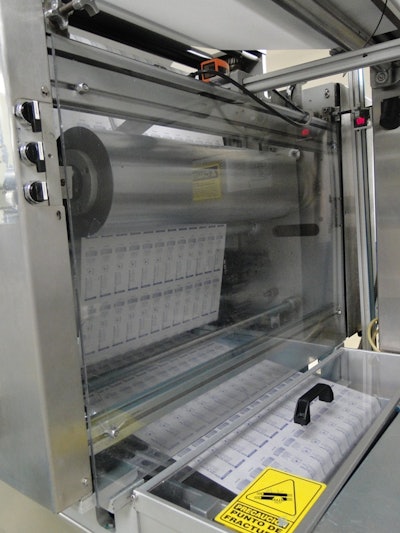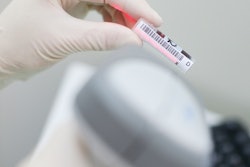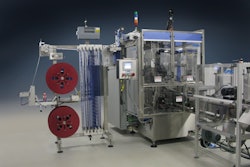
Many medical device manufacturers are sitting on the edge of their seats waiting for the White House to release a proposed rule requiring them to print "unique device identifiers" (UDIs) on their products and their packaging. But not Becton, Dickinson and Company. BD is way ahead of much of the industry in assigning, printing, and utilizing global trade identification numbers (GTINs) on all its U.S. manufactured products. (The photo here from BD shows GTIN labels being printed.)
It is also far into an industry-leading joint program with the Mercy Health System in the Midwest, whose ROi supply chain company has been engaged with BD in the kind of packaging data integration program that is rare in the medical device industry but common in the drug industry. The pioneering BD/ROi integration program includes approximately 650 products and 950 total GTINs.
BD has been printing 14-digit GTINs on almost all its products coming off U.S. production lines. In some situations, those GTINs are printed on the unit-of-use item, the shelf packaging, and the case. But sometimes the product is only marked on the case. BD prints a second linear bar code on all cases and some shelf packs. It contains the lot number, expiration date, and other production data.
"The use case in the hospital dictates what information is bar-coded on the unit-of-use, the shelf package, or the case," explains Dennis Black, director, e-Business, BD. "This applies to both GTINs and the production data. What is needed for a product used in the operating room may be different for a product used in the hospital laboratory."
Alex Zimmerman, director, Integrated Business Solutions for ROi, says about half the medical/surgical products arriving at Mercy have GTINs. What is different about the BD GTINs is that Mercy and BD have synchronized their software systems so that the two partners can send data back and forth using GTINs, which are the primary product identifier on purchase orders, invoices, and other EDI transactions. This makes ordering much easier, and recalls faster and less expensive for both parties.
"We no longer have to make phone calls back and forth for business transactions. We have automated transactional processes and have become much more precise. This has led to operational efficiency gains for both organizations," explains Black. "But the electronic data integration does take some heavy lifting."
The benefits of integration are very real. Integrated GTINs allow Mercy to feed additional patient-level data into electronic health records."One of the most intriguing aspects of our project is the ability to pick up a package, scan it, and be presented with all of the patients the product has been used on in the operating room based on what was documented in our electronic health record, explains Zimmerman. "Applications related to EHRs span from better recall management to improved identification of expired products where lot and expiration dates were stored. If the bar code wasn't unique the potential for incorrect data would render this capability unreliable and therefore not useful."
Medical device product identification
The medical device world is essentially much different than the pharmaceutical world when it comes to product identification. Drug manufacturers have been putting national drug codes (NDC) on product labels for decades. Each NDC identifies a specific drug from a specific manufacturer. There is no comparable system to identify medical devices. Each manufacturer has a choice of product numbering systems: its own proprietary system, the GS1 GTIN system, or the HIBCC LIC system. Distributors and group purchasing organizations create their own proprietary systems. So a hospital trying to identify a product faces a Tower of Babel.
The GTIN data structure established by the standards group GS1 essentially brings the equivalent of NDC numbers to the medical device world. The device manufacturers use what is called GS1 Code 128, which is displayed as a linear bar code. It is a 14-digit number that identifies a specific product made by a specific manufacturer.
Many drug manufacturers do the same, although some are moving to the more advanced GS1 Databar (formerly Reduced Space Symbology), which is essentially two, small linear bar codes stacked on top of one another. Moreover, the drug industry is heading toward "serialization" of its packages because of the California 2015 deadline for ePedigree compliance in the Golden State. There is no serialization anticipated for medical device packages.
Easy adoption to packaging lines
Because serialization is not an issue for most medical devices, BD was able to fairly easily adapt its packaging lines for GTIN printing. Those labels are either printed inline, or printed offline and applied as the package moves through production. Black says he has fielded calls from other hospital systems that have read about the BD-Mercy GTIN integration program. He is likely to field many more in the near future.
The upcoming UDI proposed rule, like a couple of recent FDA initiatives in the area of drug package tracking, stems from the FDA Amendments Act Congress passed in 2007. That law requires the FDA to force manufacturers to "mark" their devices. The FDA has moved very slowly on prescribing a UDI. The agency held a two-day workshop in early September 2011. There, Jeff Shuren, director for devices and radiological health, said, "I recognize that many of you have been waiting for this regulation for a long time, so have we."
Jay Crowley, senior advisor for patient safety, Center for Devices and Radiological Health, followed up by saying: "The UDI proposed regulation is close to coming out." Since then: nothing. The FDA sent a proposed rule to the White House Office of Management and Budget (OMB) prior to that September meeting. The OMB must approve all new proposed rules. The UDI rule is probably politically sensitive since the FDA rates it, in its regulatory agenda, as "economically significant."
Some proponents of UDI suggest the medical device manufacturers have pressed the Obama administration to water down the proposed rule. A spokesman for AdvaMed, the medical device manufacturer's association, denies that is the case.
In February, a coalition of healthcare trade associations wrote to Jeff Zients, acting director, OMB. They stated: "The great potential for UDIs to increase safety and lower costs for the American healthcare system means that widespread adoption is sorely needed now. Prompt action is also important because hospitals and physicians are in the process of implementing electronic health records as part of the Medicare and Medicaid EHR Incentive Programs."
One month later, a bipartisan group of senators introduced a bill called the Ensuring Safe Medical Devices for Patients Act. It requires the FDA to publish a final rule by the end of 2012 establishing a UDI.
Author Stephen Barlas has been a full-time freelance Washington journalist for more than 30 years, and covers the pharmaceutical industry for many publications, including Healthcare Packaging and Packaging World magazines.
It is also far into an industry-leading joint program with the Mercy Health System in the Midwest, whose ROi supply chain company has been engaged with BD in the kind of packaging data integration program that is rare in the medical device industry but common in the drug industry. The pioneering BD/ROi integration program includes approximately 650 products and 950 total GTINs.
BD has been printing 14-digit GTINs on almost all its products coming off U.S. production lines. In some situations, those GTINs are printed on the unit-of-use item, the shelf packaging, and the case. But sometimes the product is only marked on the case. BD prints a second linear bar code on all cases and some shelf packs. It contains the lot number, expiration date, and other production data.
"The use case in the hospital dictates what information is bar-coded on the unit-of-use, the shelf package, or the case," explains Dennis Black, director, e-Business, BD. "This applies to both GTINs and the production data. What is needed for a product used in the operating room may be different for a product used in the hospital laboratory."
Alex Zimmerman, director, Integrated Business Solutions for ROi, says about half the medical/surgical products arriving at Mercy have GTINs. What is different about the BD GTINs is that Mercy and BD have synchronized their software systems so that the two partners can send data back and forth using GTINs, which are the primary product identifier on purchase orders, invoices, and other EDI transactions. This makes ordering much easier, and recalls faster and less expensive for both parties.
"We no longer have to make phone calls back and forth for business transactions. We have automated transactional processes and have become much more precise. This has led to operational efficiency gains for both organizations," explains Black. "But the electronic data integration does take some heavy lifting."
The benefits of integration are very real. Integrated GTINs allow Mercy to feed additional patient-level data into electronic health records."One of the most intriguing aspects of our project is the ability to pick up a package, scan it, and be presented with all of the patients the product has been used on in the operating room based on what was documented in our electronic health record, explains Zimmerman. "Applications related to EHRs span from better recall management to improved identification of expired products where lot and expiration dates were stored. If the bar code wasn't unique the potential for incorrect data would render this capability unreliable and therefore not useful."
Medical device product identification
The medical device world is essentially much different than the pharmaceutical world when it comes to product identification. Drug manufacturers have been putting national drug codes (NDC) on product labels for decades. Each NDC identifies a specific drug from a specific manufacturer. There is no comparable system to identify medical devices. Each manufacturer has a choice of product numbering systems: its own proprietary system, the GS1 GTIN system, or the HIBCC LIC system. Distributors and group purchasing organizations create their own proprietary systems. So a hospital trying to identify a product faces a Tower of Babel.
The GTIN data structure established by the standards group GS1 essentially brings the equivalent of NDC numbers to the medical device world. The device manufacturers use what is called GS1 Code 128, which is displayed as a linear bar code. It is a 14-digit number that identifies a specific product made by a specific manufacturer.
Many drug manufacturers do the same, although some are moving to the more advanced GS1 Databar (formerly Reduced Space Symbology), which is essentially two, small linear bar codes stacked on top of one another. Moreover, the drug industry is heading toward "serialization" of its packages because of the California 2015 deadline for ePedigree compliance in the Golden State. There is no serialization anticipated for medical device packages.
Easy adoption to packaging lines
Because serialization is not an issue for most medical devices, BD was able to fairly easily adapt its packaging lines for GTIN printing. Those labels are either printed inline, or printed offline and applied as the package moves through production. Black says he has fielded calls from other hospital systems that have read about the BD-Mercy GTIN integration program. He is likely to field many more in the near future.
The upcoming UDI proposed rule, like a couple of recent FDA initiatives in the area of drug package tracking, stems from the FDA Amendments Act Congress passed in 2007. That law requires the FDA to force manufacturers to "mark" their devices. The FDA has moved very slowly on prescribing a UDI. The agency held a two-day workshop in early September 2011. There, Jeff Shuren, director for devices and radiological health, said, "I recognize that many of you have been waiting for this regulation for a long time, so have we."
Jay Crowley, senior advisor for patient safety, Center for Devices and Radiological Health, followed up by saying: "The UDI proposed regulation is close to coming out." Since then: nothing. The FDA sent a proposed rule to the White House Office of Management and Budget (OMB) prior to that September meeting. The OMB must approve all new proposed rules. The UDI rule is probably politically sensitive since the FDA rates it, in its regulatory agenda, as "economically significant."
Some proponents of UDI suggest the medical device manufacturers have pressed the Obama administration to water down the proposed rule. A spokesman for AdvaMed, the medical device manufacturer's association, denies that is the case.
In February, a coalition of healthcare trade associations wrote to Jeff Zients, acting director, OMB. They stated: "The great potential for UDIs to increase safety and lower costs for the American healthcare system means that widespread adoption is sorely needed now. Prompt action is also important because hospitals and physicians are in the process of implementing electronic health records as part of the Medicare and Medicaid EHR Incentive Programs."
One month later, a bipartisan group of senators introduced a bill called the Ensuring Safe Medical Devices for Patients Act. It requires the FDA to publish a final rule by the end of 2012 establishing a UDI.
Author Stephen Barlas has been a full-time freelance Washington journalist for more than 30 years, and covers the pharmaceutical industry for many publications, including Healthcare Packaging and Packaging World magazines.





















